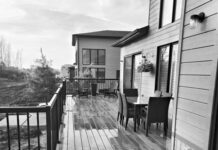QuietZone Pink Next Gen Fiberglas Insulation: Quiet that adds up – one bag at a time
Owens Corning Canada
CHBA’s Net Zero Council supports innovation in the residential construction industry with the goal of creating a market advantage for CHBA builder and renovator members voluntarily pursuing Net Zero performance. The Council’s work will help to meet the housing aspirations of Canadians and renew Canadian leadership in high performance housing. To support the advancement of Net Zero housing in Canada, a few of the 2025 CHBA Net Zero Council Gold and Silver sponsors have offered up their solutions to help CHBA builders and renovators in their adoption of Net Zero performance.
Calculate your savings with Owens Corning Canada QuietZone insulation at owenscorning.com/en-ca/insulation/products/quietzone-next-gen/quietzone-calculator/
Panasonic heat pumps: The retrofit solution for Homestead Apartments
Panasonic
Homestead Land Holdings – one of Canada’s largest landlords – couldn’t justify the unacceptably high operating costs of two of its buildings. Aging systems had led to excessive electricity consumption and mounting repair bills, and the decades-old HVAC equipment – packaged terminal air conditioners (PTACs) in one building and electric in-floor heating in the other – were no longer meeting tenants’ expectations.
Homestead needed to find an affordable, energy-efficient solution capable of delivering consistent heating and cooling throughout each apartment, supported by accurate, user-friendly controls.
The company set up two pilot projects designed to assess the long-term performance of their chosen solution, Panasonic Ductless Air Source Heat Pumps (DASHPs).
Over a year, Homestead measured the electricity consumption of the new DASHPs and old PTACS in two similar apartments, for comparison. The company also collected temperature readings to verify that the DASHPs were keeping up with heating and cooling demand. When the year was over, Homestead found that the new heat pumps had achieved an astonishing 68-per-cent savings on electricity costs, prompting the company to install Panasonic DASHPs throughout the two apartment buildings.
On top of the cost savings, the Panasonic DASHPs, some of which are equipped with nanoe X technology – an effective solution for reducing odours and inhibiting pollen and allergens – played a huge role in not only promoting healthier living but also creating superior air quality for the tenants. The tenants reported that the Panasonic DASHPs provided instant heating/cooling and better air circulation, eliminating noticeable hot/cold spots for a more even profile across each temperature zone. They also reported having better control over their living space, citing major improvements such as automatic temperature and occupancy settings, Wi-Fi connectivity and more.
Find out more about Breathe Well by Panasonic heating and cooling solutions at na.panasonic.ca/indoor-air-quality/hvac
Building to higher Step Code levels regardless of energy source
FortisBC
Since 2011, FortisBC has been offering the New Home Program to help builders and developers in their efforts to construct new homes that are more energy efficient than minimum BC Building Code requirements. Recently, the company presented new rebates to help lower the costs of incorporating higher energy efficiency into new home construction and building to higher code standards. This revised rebate program will help support builders and developers achieve Step 4 and Step 5 of the BC Energy Step Code regardless of the energy source, while providing homeowners with a comfortable home.
Today, gas customers also have a percentage of their gas designated as Renewable Natural Gas1 (RNG) through FortisBC’s designated RNG blend.
Step 5 of that code indicates that the home has been constructed as net-zero energy ready, meaning it has the ability to achieve net-zero energy by using renewable energy sources, such as solar panels. A net-zero energy home produces as much energy as it consumes on an annual basis.
FortisBC believes in a successful transition to a Net Zero future, including investing, owning and operating in energy infrastructure that reduces greenhouse gas (GHG) emissions while maintaining a resilient, reliable and affordable energy system.
The CleanBC Roadmap to 2030 reaffirms that B.C.’s gas delivery system will continue to play a role in the province’s energy future moving forward and outlines ways to improve energy efficiency in homes and buildings.
For more information about FortisBC’s New Home Program rebates, visit fortisbc.com
1Renewable Natural Gas (also called RNG or biomethane) is produced in a different manner than conventional natural gas. It is derived from biogas, which is produced from decomposing organic waste from landfills, agricultural waste and wastewater from treatment facilities. The biogas is captured and cleaned to create RNG. When RNG is added to North America’s natural gas system, it mixes with conventional natural gas. This means FortisBC is unable to direct RNG to a specific customer. But the more RNG is added to the gas system, the less conventional natural gas is needed, thereby reducing the use of fossil fuels and overall greenhouse gas emissions.
Building Net Zero starts with the envelope
All Weather at Home
Net Zero isn’t just about what’s behind the walls of a home. The story really starts at the envelope – and that’s where windows and doors step up. For builders working toward higher tiers of energy performance, the right glazing solution can make a measurable impact on both emissions and long-term resilience.
In many Canadian climate zones, windows and doors are responsible for up to 25 per cent of a home’s energy loss. High-performance solutions, such as triple-glazed IGUs and low-conductivity spacers, help keep indoor temperatures steady all year long. That means homeowners enjoy a new level of comfort in every season. With All Weather at Home’s range of low-e coatings – including the new ComfortMax 366 series – builders get the flexibility to dial in exactly what a Net Zero project needs.
But beyond efficiency, durability matters too. A resilient envelope must handle wind, moisture and the full range of Canadian temperature swings. Leading window and door systems now push for higher performance grades, with frame materials that resist warping or swelling over time. After all, a Net Zero home isn’t just efficient on Day 1 – it’s built to stay that way for decades.
For multi-family projects, the stakes are even higher. Continuous insulation and airtightness mean every component needs to integrate seamlessly and meet the codes that keep getting stricter. To answer rising performance levels, All Weather at Home is preparing to launch AquaGuard – a high-performance entry door system, engineered for the water resistance and durability multi-family builds demand.
Partnering with a manufacturer that understands both code and construction makes the difference. All Weather at Home prides themselves on being hands-on with builders – optimizing performance, streamlining installation and making sure their products are ready for Canada’s evolving Net Zero landscape.
When you’re building for emissions reduction and resilience, every detail adds up – and your envelope is where it all begins.
Explore All Weather at Home’s full range of high-performance solutions at allweatherathome.ca
Appealing electric solutions for multi-unit developments
Mitsubishi Electric Heating & Cooling
Westman Village is a development by Jayman BUILT located in the community of Mahogany in Calgary. The project thoughtfully weaves convenience, diversity and accessibility into an all-inclusive suburban community concept. Redefining the way new homes are built, bought and lived in, the carefully designed community includes condominiums, townhomes, seniors’ residences and long-term leasing condos.
According to Dennis Aucoin, the senior development manager for Westman Village, many of the prospective residents and homeowners were downsizing. To offer them an attractive product, the units needed to be quiet, and the building had to create a seamless transition with top-quality products that would meet high expectations. This includes everything from the finishes to the heating and air conditioning units. The heating and cooling units also had to be energy efficient, as Jayman BUILT prides itself on green construction.
That’s where Mitsubishi Electric came in. With more than 100 years of experience in providing reliable, high-quality products to both commercial and residential consumers all over the world, Mitsubishi Electric is a recognized world leader in the manufacturing, marketing and sales of electrical and electronic equipment used in information processing and communications, consumer electronics, industrial technology, energy, transportation and construction.
“We were attracted to the Mitsubishi Electric brand because we consider it the Cadillac of heating and cooling units,” says Aucoin.
The Westman Village project is Mitsubishi Electric’s largest Canadian multi-unit residential development. Mitsubishi Electric individual split and centralized variable refrigerant flow (VRF) units were chosen, thanks to their efficiency and reputation. Their whisper-quiet sound was also a deciding factor – the units emit about half the noise of a regular unit in a house. Further, the slim, suitcase-style units were also perfect for more compact living spaces.
Ease of maintenance was also a deciding factor. “For us getting into leased seniors and rentals, we wanted a product that was going to be somewhat maintenance free and last the test of time,” explains Aucoin.
Finally, the Mitsubishi Electric VRF units are all about consumer comfort and use unique design and engineering solutions to deliver it. Typically, a normal air conditioner runs at full blast, cooling the entire space then shutting off. But these units are built to get to a certain temperature and maintain it. Overall, this allows for lower energy use and improved comfort.
Learn more about Mitsubishi Electric systems at mitsubishielectric.ca
Net Zero meets ultra high-performance concrete
Kustom Precast Concrete
Building smarter with Kustom Precast Koncrete
Kustom Precast Koncrete believes the future of construction lies in combining strength, efficiency and sustainability. That’s why they’ve worked tirelessly to design a new generation of insulated concrete wall panels – built to perform both below and above grade.
Energy efficiency without compromise
Kustom Precast Koncrete insulated wall panels are engineered to deliver an effective R-30+ thermal rating, helping builders meet and exceed today’s net-zero energy requirements. At the same time, the panels use up to 50 per cent less concrete than a traditional eight inch. foundation wall, reducing both material costs and carbon footprint.
Smarter by design
Every panel comes with integrated vertical and horizontal electrical chases, making wiring easier and faster. They also feature steel furring channels at 16 inches on centre, so finishing interior walls is straightforward – no extra framing required.
Strength meets innovation
Behind this system is the company’s proprietary ultra-high-strength concrete mix, designed to deliver superior structural performance with less material. The result: Stronger walls, lighter environmental impact and a more efficient building process.
A complete system
They’re not stopping at walls. The team at Kustom Precast Koncrete is also developing precast concrete floor panels that pair seamlessly with their wall system. These floor panels span longer distances, reduce the need for extra supports and simplify construction – giving builders more flexibility and savings on site.
Built for the future
Kustom Precast Koncrete isn’t just focused on efficiency; the company is building resilience. Its wall and floor systems are designed to stand up to flooding, fire and high winds – delivering peace of mind in a world where durability matters more than ever. With innovation, sustainability and performance at the core of every design, Kustom Precast Koncrete is helping builders create smarter, stronger and more sustainable buildings for the future.
Learn more about Kustom Precast Concrete wall and floor systems at kustomprecast.com
How combination heating systems can help builders achieve high-performance and affordability
Reliance Home Comfort
Systems that prioritize energy efficiency are growing in popularity among builders – and combination heating systems (or combi boilers) are helping builders offer high-performance systems and affordability to their customers.
Combi boilers are hydronic-based mechanical systems that have a dual purpose: they provide domestic hot water and space heating and offer some advantages when compared to typical forced air gas furnaces and hot water tanks.
Reliance Home Comfort, which services more than two million customers across Canada, is a leading provider of combi boilers for multi-unit rental buildings. With a dedication to helping homebuilders work towards Net Zero, the company’s Director of Builder Markets, Shannon Bertuzzi, says builders can expect a high level of service and expertise from Reliance.
“We know what solutions are helping move the needle towards Net Zero,” says Bertuzzi, adding that Reliance is attuned to code changes and sits on the CHBA Net Zero Council. “Our involvement in the Council lets us offer input into new systems that help builders achieve high-performance housing.”
When working with Reliance, builders are assigned both an account manager and technical manager to ensure they receive high-end systems that add great value for homeowners. This is showcased by a recent example in which a Reliance Key Account Manager worked with a builder in Vaughan, Ont. to help them select the appropriate equipment for their townhouse project. The builder included a tested combi boiler system in its 111 townhomes and a hot water recirculation pump to help reduce water consumption.
Bertuzzi emphasizes that Reliance is more than a water heating company. “We offer builders a multitude of products, including smart home technology, HVAC equipment and even EV charging solutions.”
Bertuzzi stresses innovation is essential in the residential construction industry and builders play an important role by testing new systems in their projects. “Collaboration is vital to successfully transform the housing stock.”
Learn more about how Reliance helps builders reach high-
performance and affordability at reliancebuilderprogram.com
– Marc Huminilowycz, award-winning content writer and editor specializing in green building and energy-efficient homes.











